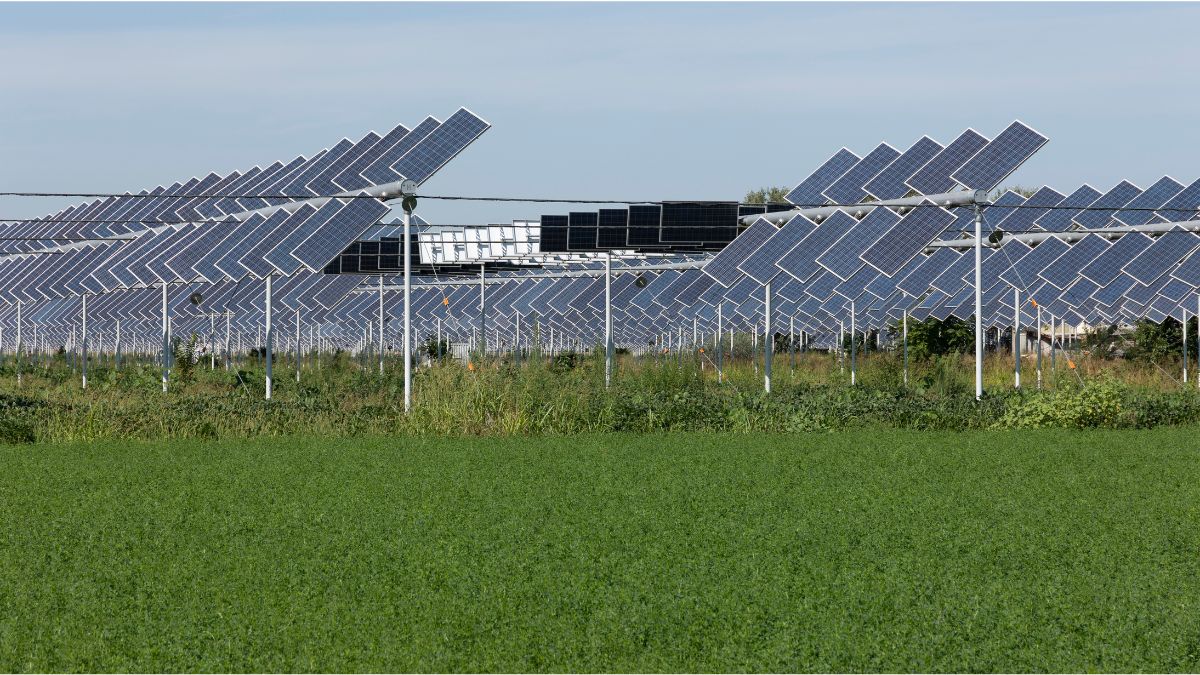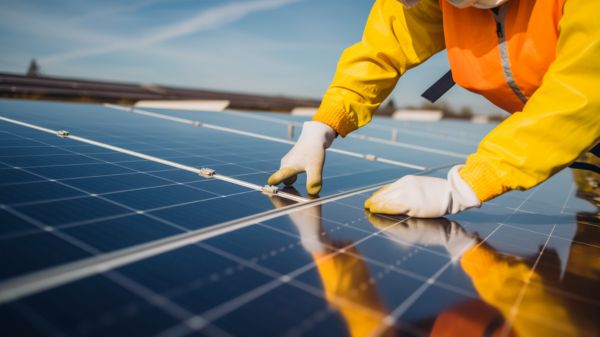Growing Green Energy: The Benefits of Agrivoltaics on Farms
Are you ready to revolutionize your farm and harness the power of the sun? Agrivoltaics could be the answer! In this article we’ll be exploring some of the benefits of agrivoltaics to help you revolutionize farming by combining solar energy with agricultural practices.
Agrivoltaics is a cutting-edge system that combines agriculture and solar energy generation. By raising solar panels above the ground and cultivating plants underneath, you can maximize both food production and renewable energy.
Imagine the possibilities: optimizing sunlight for your crops, creating a more stable microclimate, and even earning extra income through energy generation. Join the agrivoltaics movement and grow green energy on your farm today!
Key Takeaways
- Agrivoltaics combines agriculture and solar panels, creating a dual-use system that benefits both food production and solar energy generation.
- Agrivoltaics can lead to increased crop yield, with studies showing that it can increase fruit production and provide plants with more stable temperatures.
- Plants and solar panels form a symbiotic relationship in agrivoltaics, with plants helping to keep the panels cool and the panels providing shade and temperature regulation for the plants.
- Agrivoltaics can be profitable by reducing electric bills, earning credits through net metering, selling energy certificates, and participating in community solar programs.
What Is Agrivoltaics
Agrivoltaics combines agriculture and solar panels, creating a dual-use system that benefits both food production and solar energy generation. This innovative approach has numerous applications in various types of farms and agricultural practices.
Research advancements and case studies have shown promising results and future prospects for agrivoltaics. By raising solar panels above the ground and growing plants underneath, agrivoltaics optimizes sunlight for crops, preventing light stress and excessive water usage. Studies have also indicated increased fruit production and larger leaves in plants grown in agrivoltaic systems.
Furthermore, the symbiotic relationship between plants and solar panels in agrivoltaics enhances energy output. Plants help cool the panels through evapotranspiration, resulting in more efficient energy generation.
Agrivoltaics not only offers environmental benefits but also provides opportunities for profitability and reduced energy usage through net metering, battery storage, and participation in solar programs.
Good Read: Agrivoltaics: Everything Farmers Need to Know About Solar Panels (2023)
Design and Implementation of Agrivoltaics
The implementation and design of agrivoltaics include positioning raised solar panels at an optimal angle and spacing panel clusters a few feet apart. This optimal design allows for maximum plant growth and solar energy generation. The raised panels are typically placed five to ten feet above the ground, providing enough space for plants to grow underneath.
By spacing the panel clusters a few feet apart, additional sunlight and farming space are provided. This strategic panel spacing ensures that plants receive just enough sunlight, preventing light stress and excessive water usage. The combination of raised panels and proper panel spacing creates a symbiotic relationship between plant growth and solar energy output.
The plants benefit from the shade and temperature regulation provided by the panels, while the cooler panels perform more efficiently and produce more energy. This optimal design of agrivoltaics allows for successful dual-use of land, benefiting both agriculture and solar energy generation.
| Agrivoltaics Implementation | Optimal Design |
|---|---|
| Raised solar panels positioned at an optimal angle | Maximum plant growth and solar energy generation |
| Panel clusters spaced a few feet apart | Additional sunlight and farming space |
Benefits of Agrivoltaics on Crop Yield
You can maximize crop yield by implementing agrivoltaics. Studies have shown increased fruit production and larger leaves in plants grown under solar panels. Agrivoltaics offers a sustainable agriculture solution that enhances productivity while promoting climate resilience and water conservation.
The strategic placement of solar panels above crops optimizes sunlight, preventing light stress and excessive water usage. This innovative approach creates a microclimate that provides more stable temperatures, benefiting plant growth.
The symbiotic relationship between plants and solar energy output in agrivoltaics further contributes to increased productivity. Plants help keep the panels cool through evapotranspiration, resulting in more efficient energy generation.
Additionally, agrivoltaics offers the opportunity for energy independence. Generated energy can power your farm and home, reducing electric bills, while excess energy can be stored or sold, promoting financial sustainability.
Symbiotic Relationship Between Plants and Solar Energy Output
To optimize solar energy output and plant growth, it’s important to understand the symbiotic relationship between plants and solar panels in agrivoltaics.
In this system, plants and solar panels work together to benefit each other. Plants play a crucial role in keeping the panels cool through evapotranspiration, which helps maintain their efficiency and increases energy production.
At the same time, the solar panels provide shade and regulate temperature for the plants, creating a favorable microclimate. This mutual relationship leads to increased crop production as plants receive optimal sunlight without experiencing light stress or excessive water usage.
Additionally, the larger leaves and increased surface area for photosynthesis in agrivoltaic plants contribute to their enhanced productivity.
Overall, the symbiotic relationship between plants and solar panels in agrivoltaics offers numerous benefits, including improved efficiency of solar panels and increased crop yield.
Profitability and Energy Usage in Agrivoltaics
Excess energy can be stored in the grid through net metering, allowing for credits to be earned in agrivoltaics. This means that you can sell the excess energy produced by your agrivoltaic system back to the grid, reducing your electric bills and even earning extra income.
By participating in net metering, you can achieve both economic viability and energy independence.
Agrivoltaics not only benefit your bottom line but also contribute to environmental sustainability. By generating renewable energy on your farm, you reduce your reliance on fossil fuels and minimize your carbon footprint.
Additionally, there are financial incentives available for implementing agrivoltaics, such as Solar Renewable Energy Certificates (SRECs) and community solar program. These incentives further enhance the profitability of agrivoltaic systems while promoting renewable energy integration in your community.
Opportunities for Agrivoltaics
Consider exploring the various opportunities for implementing agrivoltaics on different types of land, such as unused spaces or rooftops, to maximize the benefits of both agriculture and solar energy generation.
Agrivoltaics has significant market potential, offering a unique approach to agricultural diversification and renewable energy integration. By harnessing the power of the sun and utilizing land effectively, agrivoltaics can contribute to sustainable practices like water conservation and land utilization.
This innovative system allows for the cultivation of crops underneath solar panels, optimizing land use and increasing crop yield. Research has shown that agrivoltaics can lead to more stable temperatures, reduced water usage, and increased fruit production.
Environmental Impacts of Agrivoltaics
Maximize the environmental benefits of agrivoltaics by exploring its potential to mitigate soil erosion and contribute to carbon sequestration.
Agrivoltaics, the combination of agriculture and solar panels, offers a sustainable solution for farmers and the environment. By implementing agrivoltaics on farms, we can achieve climate resilience, biodiversity conservation, carbon footprint reduction, and water conservation.
Agrivoltaics helps combat soil erosion by providing a protective layer of vegetation underneath solar panels. The plants act as a natural barrier, preventing soil erosion caused by wind and rain. Additionally, the plants’ root systems help stabilize the soil, further reducing erosion risks.
In terms of carbon sequestration, agrivoltaics plays a significant role. The plants grown under the solar panels absorb carbon dioxide from the atmosphere through photosynthesis, effectively reducing greenhouse gas emissions and contributing to carbon sequestration. This approach helps combat climate change and promotes environmental sustainability.
Furthermore, agrivoltaics promotes biodiversity conservation. The combination of solar panels and vegetation creates a diverse ecosystem, providing habitats for various plants and animals. This increased biodiversity contributes to the overall health of the environment, making it more resilient to climate change impacts.
Agrivoltaics also contributes to water conservation. The plants grown underneath the solar panels help retain moisture in the soil, reducing the need for irrigation. This not only conserves water but also reduces the energy required for pumping and distributing water, further reducing the carbon footprint.
Cost and Advantages of Agrivoltaics
You can save money by implementing agrivoltaics on your property due to reduced electricity costs and potential income from selling excess energy. Agrivoltaics offers a cost-effective solution that combines agriculture and solar energy generation.
To determine the economic feasibility of agrivoltaics, a cost analysis and ROI calculation should be conducted. The initial investment of installing solar panels may seem daunting, but the long-term savings outweigh the upfront costs. By generating your own electricity, you can significantly reduce your reliance on the grid and lower your energy expenses.
Additionally, financial incentives such as net metering and Solar Renewable Energy Certificates (SRECs) allow you to earn credits or sell energy certificates, further boosting your savings. The symbiotic relationship between plants and solar panels in agrivoltaics not only benefits crop yield but also maximizes energy output, creating a win-win situation.
Consider implementing agrivoltaics to enjoy the financial advantages and contribute to a sustainable future.
Regulations for Agrivoltaics Installation
To ensure successful implementation of agrivoltaics, it is important to be aware of the regulations surrounding the installation process. Regulatory requirements play a crucial role in ensuring the safe and efficient integration of solar panels and agriculture.
The permitting process for agrivoltaics involves obtaining necessary approvals from local authorities, which may include environmental assessments and land use permits. Compliance guidelines must be followed to ensure that the installation meets all necessary standards and regulations. Policy considerations such as zoning and land use policies should also be taken into account during the planning phase.
Installation standards dictate the proper positioning and spacing of solar panels to optimize sunlight for plants and ensure their growth and productivity. By adhering to these regulations, you can ensure a smooth and successful installation of agrivoltaics on your farm.
Tips for Setting Up an Agrivoltaic System
Now that you understand the regulations for installing an agrivoltaic system, let’s discuss some tips for setting up your own system. When it comes to maintenance requirements, regular inspection of the solar panels is essential to ensure optimal energy generation. Additionally, proper irrigation techniques should be implemented to provide adequate water to the plants while avoiding overwatering.
Choosing suitable plants that can thrive in the shaded environment created by the solar panels is crucial for the success of your agrivoltaic system. Optimal panel spacing is also important to maximize sunlight exposure for the plants.
Finally, it’s important to be aware of potential challenges such as pest control and the potential for shading from neighboring vegetation. By following these tips, you can set up a successful agrivoltaic system on your farm.
| Tips for Setting Up an Agrivoltaic System |
|---|
| – Regularly inspect solar panels for maintenance requirements. |
| – Implement proper irrigation techniques for optimal plant growth. |
| – Choose suitable plants that thrive in shaded environments. |
| – Optimize panel spacing to maximize sunlight exposure. |
| – Be aware of potential challenges such as pest control and shading. |
Conclusion
Congratulations! You’ve reached the end of this informative journey into the world of agrivoltaics. By now, you must be convinced of the numerous benefits this green energy solution offers.
From optimizing crop yield to providing shade and temperature regulation, agrivoltaics proves to be a symbiotic marvel. Not to mention the profitability it brings through energy usage and participation in community solar programs.
Who would have thought that raising solar panels above crops could yield such ironic advantages? So go ahead, embrace the irony and reap the benefits of agrivoltaics for a greener future.






